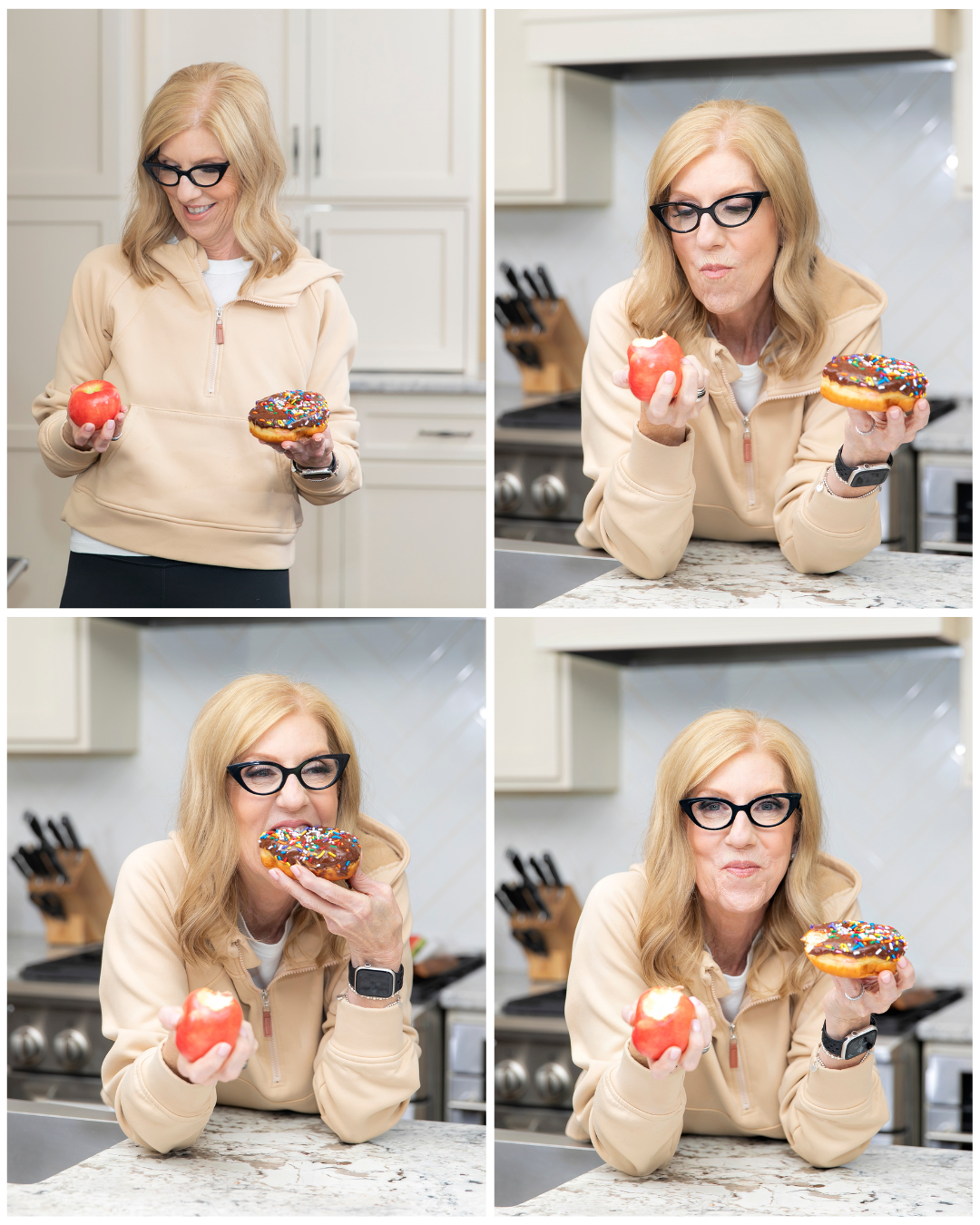Carb Facts for Menopausal Weight Loss
Menopause Weight Loss: Carbs & Calories
In the quest for weight loss, many people turn to the seemingly simple solution of cutting carbs. It’s an idea that’s been popularized by countless diet trends, from Atkins to Keto. But here’s the thing—focusing solely on cutting carbs might not be the golden ticket to the weight loss you desire. Let’s break it down and understand why.

Carb-Busting Myths
Carbs Make You Fat
This is one of the most pervasive myths. Carbohydrates themselves do not cause weight gain. Overeating and consuming more calories than your body needs is what leads to weight gain. By choosing healthy, whole-food sources of carbs and managing your portions, you can enjoy carbs as part of a balanced diet.
Low-Carb Diets Are the Only Way to Lose Weight
While low-carb diets can be effective for some people, they are not the only path to weight loss. Different approaches work for different individuals. The key is finding a sustainable way of eating that fits your lifestyle and preferences while creating a calorie deficit.
Cutting Carbs Leads to Immediate Weight Loss
Initial weight loss on a low-carb diet is often due to water loss rather than fat loss. Carbohydrates are stored in the muscles and liver as glycogen, which binds water. When you reduce carb intake, your body uses these glycogen stores, leading to a quick drop in water weight. However, long-term weight loss requires a consistent calorie deficit.
Understanding Carbs
What Are Carbs?
Carbohydrates, or carbs, are one of the three main macronutrients, along with proteins and fats. They are the body's primary source of energy, especially for the brain and muscles. Carbs are found in a variety of foods, including:
- Sugars: Simple carbs found in fruits, vegetables, and dairy products.
- Starches: Complex carbs found in foods like bread, pasta, and potatoes.
- Fiber: A type of carb that the body cannot digest, found in fruits, vegetables, whole grains, and legumes.
What Carbs Are Not
Carbs are not inherently bad or unhealthy. They are not solely responsible for weight gain, and they are not something that needs to be eliminated entirely from your diet. The key is to choose the right types of carbs and consume them in appropriate amounts.
Net Carbs vs. Total Carbs
How Manufacturers Determine Net Carbs
Net carbs are calculated by subtracting fiber and certain sugar alcohols from the total carbohydrate count on food labels. The idea is that these components do not significantly affect blood sugar levels, so they are not counted in the net carb total. For example:
- Total Carbs: 20 grams
- Fiber: 8 grams
- Sugar Alcohols: 2 grams
- Net Carbs: 10 grams (20 - 8 - 2)
What Net Carbs Mean to the Average Dieter
For the average dieter, net carbs can be misleading. While a product may be low in net carbs, it can still be high in calories, fats, and sugars. This focus on net carbs might lead to the consumption of foods that are not necessarily healthy or conducive to weight loss.
Calories: The Big Picture
Instead of obsessing over the “little c” carbs, it’s time to shift our focus to the “big C”—calories. Weight loss fundamentally boils down to creating a calorie deficit, where you consume fewer calories than your body uses. This principle holds true regardless of the macronutrient composition of your diet.
Determining Your Daily Calorie Needs
To determine your daily calorie needs for weight loss and maintenance, you can use several methods, including online calculators that take into account your age, gender, weight, height, and activity level.
Here’s a simplified approach:
- Multiply your current weight by 15 — that's roughly the number of calories per pound of body weight needed to maintain your current weight.
- Take your REALISTIC goal weight multiplied by 12 — that's roughly the number of calories per pound of body weight needed. Let's say you're a woman who is 5 feet, 4 inches tall and weighs 155 pounds, and you need to lose about 15 pounds to put you in a healthy weight range. If you multiply 140 by 12, you will get 1680, which is the number of calories per day to reach your goal.
- To lose 1% of your body weight per week — a rate that experts consider safe — your food consumption should provide 500 to 800 calories less than your total weight-maintenance calories. If, in this example of the woman weighing 155 pounds, is eating roughly 2325 calories a day to maintain her current weight, rshe would need to reduce here daily calories to between 1,525 and 1,825 - 140 x 12 = 1680. Make sense?

Balancing Act
Achieving a calorie deficit involves a balanced approach to your diet. It’s not just about eliminating one macronutrient; it’s about managing your overall intake. Here are some key points to consider:
- Nutrient Density: Opt for foods that are rich in nutrients but relatively low in calories. Vegetables, fruits, lean proteins, and whole grains are excellent choices. They provide essential vitamins, minerals, and fiber without packing on the calories.
- Portion Control: Pay attention to portion sizes. Even healthy foods can contribute to weight gain if consumed in large quantities. Use a food scale as a guide to keep portions in check. Stop winging it & guesstimating.
- Mindful Eating: Slow down and savor your meals. Eating mindfully helps you recognize hunger and fullness cues, reducing the likelihood of overeating. This practice can lead to a natural reduction in calorie intake.
- Physical Activity: Incorporate regular exercise into your routine. Physical activity not only burns calories but also boosts your metabolism, helping you maintain a healthy weight.
The Role of Carbs in a Healthy Diet
Carbohydrates are an essential part of a balanced diet. They are the body’s primary source of energy, particularly for the brain and muscles. Completely cutting out carbs can lead to several negative effects, including fatigue, poor concentration, and irritability.
Types of Carbs Matter
Not all carbs are created equal. It’s important to distinguish between simple and complex carbohydrates:
- Simple Carbs: Found in sugary snacks, sodas, and baked goods, these carbs are quickly digested, leading to rapid spikes in blood sugar levels. While it’s best to limit these, occasional treats can fit into a balanced diet.
- Complex Carbs: Found in whole grains, vegetables, legumes, and fruits, these carbs are digested more slowly, providing sustained energy and keeping you fuller for longer. They also contain fiber, which aids in digestion and promotes satiety.
Practical Tips for a Balanced Approach
Adopting a balanced approach to weight loss doesn’t mean giving up on carbs or any other food group. Here are some practical tips to help you create a sustainable and effective plan:
Plan Your Meals
Take the time to plan your meals and snacks. Include a variety of food groups in each meal to ensure you’re getting a balance of nutrients. Planning ahead can help you make healthier choices and avoid impulsive eating.
Read Labels
Become a savvy label reader. Pay attention not only to the carb content but also to the calorie count, serving size, and ingredients list. This will help you make informed choices and avoid hidden sources of calories and sugars.
Stay Hydrated
Drinking plenty of water is crucial for overall health and can aid in weight loss. Sometimes, thirst is mistaken for hunger, leading to unnecessary snacking. Aim to drink water throughout the day to stay hydrated and support your body’s functions.
Listen to Your Body
Tune into your body’s hunger and fullness signals. Eat when you’re hungry and stop when you’re satisfied. This intuitive eating approach can prevent overeating and promote a healthier relationship with food.
Be Patient and Consistent
Weight loss is a gradual process that requires patience and consistency. Avoid the temptation of quick fixes and focus on making sustainable changes to your eating habits and lifestyle.
Focusing on the Big "C": Final Thoughts
Cutting carbs is not the magic solution to weight loss. Instead, it’s about the bigger picture—balancing your overall calorie intake and choosing nutrient-dense foods. By focusing on the “big C” calories, and not just the “little c” carbs, you can achieve sustainable weight loss and better health. Embrace a balanced approach, enjoy a variety of foods, and listen to your body.
YOU ARE CAPABLE OF LIVING YOUR HEALTHIEST & HAPPIEST LIFE.
If you’re looking to create healthy habits to gain more energy, improve your sleep + shed a few pounds, you’ve landed in the right place.
Recent Posts
Meet Emily
I love encouraging + inspiring others to reach their healthiest lives through food, fitness + gratitude. As a holistic nutritionist + the founder of Thrivyest, I am passionate about creating habits to help you to live longer + thrive. To thrive in body, mind + soul through personalized, simple + practical steps ensuring you gain more energy, clarity + confidence! Let's connect!










